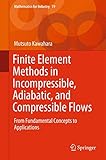Finite Element Methods in Incompressible, Adiabatic, and Compressible Flows [electronic resource] : From Fundamental Concepts to Applications / by Mutsuto Kawahara.
By: Kawahara, Mutsuto [author.].
Contributor(s): SpringerLink (Online service).
Material type: BookSeries: Mathematics for Industry: Publisher: Tokyo : Springer Japan : Imprint: Springer, 2016Description: XIV, 375 p. 119 illus., 99 illus. in color. online resource.Content type: text Media type: computer Carrier type: online resourceISBN: 9784431554509.Subject(s): Engineering | Computer mathematics | Fluids | Fluid mechanics | Engineering | Engineering Fluid Dynamics | Computational Mathematics and Numerical Analysis | Fluid- and AerodynamicsAdditional physical formats: Printed edition:: No titleDDC classification: 620.1064 Online resources: Click here to access online
BookSeries: Mathematics for Industry: Publisher: Tokyo : Springer Japan : Imprint: Springer, 2016Description: XIV, 375 p. 119 illus., 99 illus. in color. online resource.Content type: text Media type: computer Carrier type: online resourceISBN: 9784431554509.Subject(s): Engineering | Computer mathematics | Fluids | Fluid mechanics | Engineering | Engineering Fluid Dynamics | Computational Mathematics and Numerical Analysis | Fluid- and AerodynamicsAdditional physical formats: Printed edition:: No titleDDC classification: 620.1064 Online resources: Click here to access online Introduction -- Part I Introduction to Finite Element Methods in Fluid Flows -- Basic Concepts of Finite Element Method -- Pipeline systems -- Potential Flow -- Advection-diffusion -- Creeping Flow -- Part II Computational methods and applications of Finite Element Method in Fluid Flows -- Continuum Mechanics of Fluid Flows -- Analysis of Incompressible Flows -- Analysis of Adiabatic Flows -- Analysis of Compressible Flows -- ALE Formulation -- References -- Index.
This book focuses on the finite element method in fluid flows. It is targeted at researchers, from those just starting out up to practitioners with some experience. Part I is devoted to the beginners who are already familiar with elementary calculus. Precise concepts of the finite element method remitted in the field of analysis of fluid flow are stated, starting with spring structures, which are most suitable to show the concepts of superposition/assembling. Pipeline system and potential flow sections show the linear problem. The advection-diffusion section presents the time-dependent problem; mixed interpolation is explained using creeping flows, and elementary computer programs by FORTRAN are included. Part II provides information on recent computational methods and their applications to practical problems. Theories of Streamline-Upwind/Petrov-Galerkin (SUPG) formulation, characteristic formulation, and Arbitrary Lagrangian-Eulerian (ALE) formulation and others are presented with practical results solved by those methods.


There are no comments for this item.